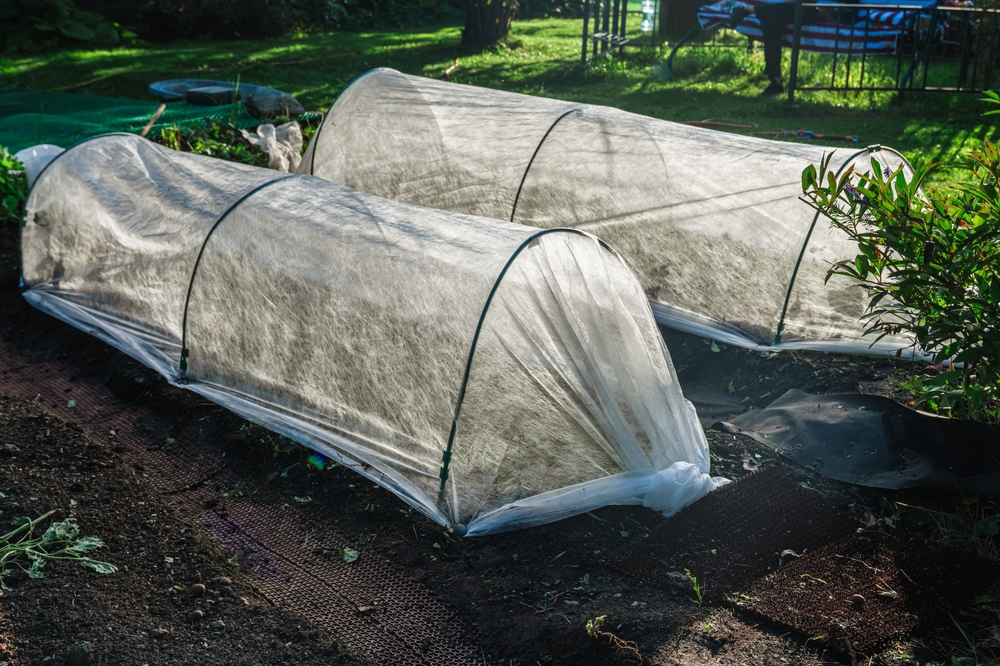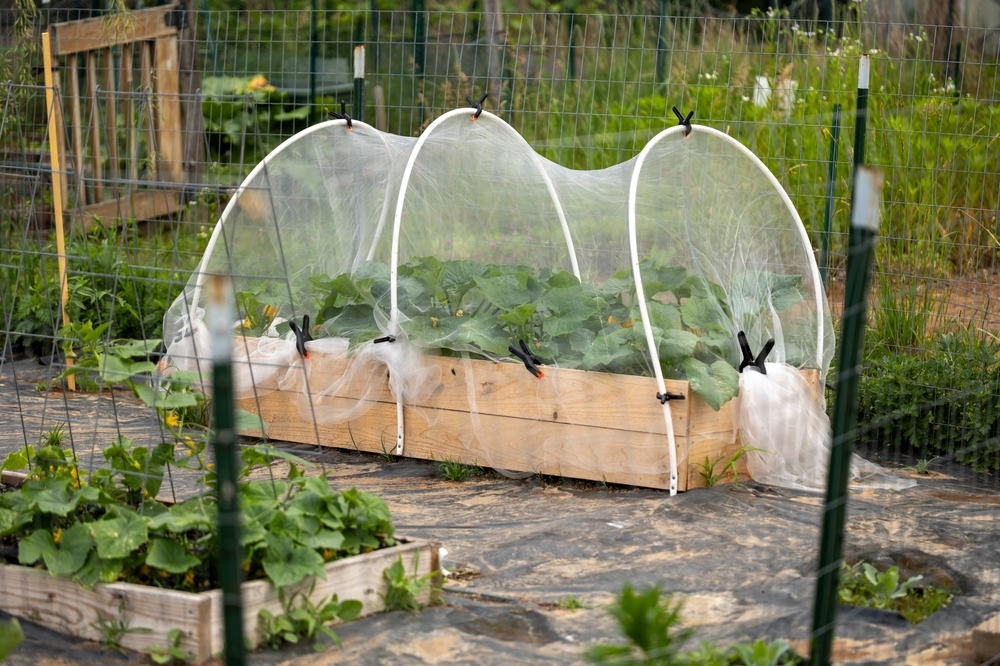
Image Source: Shutterstock.com
The first frosty morning always sneaks up on gardeners like a villain in a horror movie. One day your lettuce looks lush and happy; the next, it’s limp, icy, and begging for mercy. But fear not—there’s a way to fight back against the cold without running to the garden store or spending a fortune. DIY garden covers are your secret weapon for keeping plants alive, warm, and thriving even when winter tries to shut down your green thumb.
From upcycled materials to clever homemade solutions, here are seven cold-weather garden covers that actually work—and might even make you feel like a garden MacGyver.
1. The Classic Blanket Trick
It’s simple, it’s free, and it’s surprisingly effective. Grabbing old blankets, sheets, or comforters to drape over your plants on freezing nights creates an instant layer of warmth. Think of it as tucking your garden in for bed. The trick is to make sure the fabric doesn’t rest directly on the plants—use stakes, hoops, or even overturned buckets to keep the fabric elevated. In the morning, remove the covers once the frost melts so your plants can soak up some sunlight before the next cold front.
2. Plastic Sheeting Powerhouses
If you’ve ever seen a greenhouse, you already know the power of plastic. A simple roll of clear plastic sheeting can turn your garden bed into a cozy, heat-trapping haven. Secure it over a frame of PVC pipes or garden hoops, and you’ve got yourself a mini greenhouse in minutes. Just remember to leave some airflow by venting it during sunny days—otherwise, you’ll accidentally roast your plants instead of rescuing them. Plastic sheeting is durable, reusable, and one of the best defenses against sudden cold snaps.
3. The Upside-Down Bucket Method
When frost warnings hit and you don’t have time to build anything fancy, grab your stash of buckets, pots, or even large bowls. Placing them upside down over vulnerable plants creates a quick and surprisingly effective microclimate. The trapped air under the bucket stays warmer than the freezing air outside, shielding tender leaves from frost damage. In the morning, remove the covers as soon as the temperature rises so your plants don’t overheat. This trick works best for smaller plants like herbs, strawberries, and young greens.
4. Row Covers from Old Curtains
Here’s your excuse to finally put those old sheer curtains to use. Lightweight fabric like tulle or netting makes for excellent DIY row covers that protect plants from frost while still letting in sunlight and moisture. Simply drape the material over hoops or stakes and secure the edges with rocks or garden clips. It’s elegant in a shabby-chic way—like your garden’s wearing its Sunday best. Plus, these covers double as pest protection in warmer months, making them a versatile addition to your gardening toolkit.
5. The Milk Jug Magic Dome
If you’ve got a recycling bin full of empty milk jugs, you’re sitting on a goldmine of frost protection. Cut the bottoms off, rinse them out, and place them over small plants for an instant cold-weather dome. The jug traps heat from the soil and sunlight, keeping your plants snug even on icy nights. During the day, just twist off the caps for ventilation. It’s cheap, effective, and ridiculously satisfying to look out at a row of little glowing domes protecting your seedlings.
6. Straw Mulch Insulation
Sometimes the best defense is right at your feet—literally. A thick layer of straw mulch acts like a natural blanket, keeping the soil warm and roots insulated. It doesn’t just protect against frost—it also prevents soil erosion and retains moisture through dry winter winds. Spread it generously around root crops, perennials, and any plants that hate cold feet. When spring arrives, simply rake it back into your compost pile and enjoy how healthy your soil looks underneath.

Image Source: Shutterstock.com
7. The Homemade Cold Frame
If you’re feeling ambitious, building a cold frame is like giving your plants a private winter condo. Using scrap wood, old windows, or even clear plastic lids, you can create a mini greenhouse box that traps heat while keeping frost out. The slanted lid allows sunlight to enter and keeps rain and snow from accumulating. Cold frames are ideal for extending your growing season well into winter—and they’re easy to customize for your garden’s size. Once you build one, you’ll wonder how you ever survived a winter without it.
Keep Calm and Cover On
Cold weather doesn’t have to mean the end of your gardening season. With a few creative DIY covers and a dash of resourcefulness, you can keep your plants thriving long after your neighbors have packed it in for the year. Whether you’re using blankets, plastic sheets, or milk jugs, each method has its own charm—and a serious impact on plant survival. So before the next frost sneaks up on you, grab what you’ve got and get to covering!
Have you tried any of these cold-weather hacks in your own garden? Share your favorite DIY tricks or chilly-weather success stories in the comments below.
You May Also Like…
7 DIY Greenhouse Hacks for Fall Growing
8 DIY Sprays That Experts Say Cause More Harm Than Help
7 Garden Tasks to Protect Bees in Autumn
10 Garden Tasks That Prevent Spring Weeds
6 Cold Weather Herbs That Keep Producing Indoors
Leave a Reply